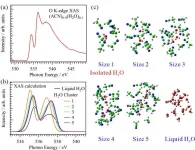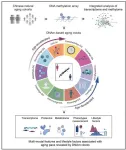(Press-News.org) Embargoed until 4 a.m. CT/5 a.m. ET Tuesday, June 4, 2024
DALLAS, June 4, 2024 — Driven by an older, more diverse population, along with a significant increase in risk factors including high blood pressure and obesity, total costs related to cardiovascular disease (CVD) conditions are likely to triple by 2050, according to projections from the American Heart Association, observing 100 years of lifesaving service as the world’s leading nonprofit organization focused on heart and brain health for all. At least 6 in 10 U.S. adults (61%), more than 184 million people, are expected to have some type of CVD within the next 30 years, reflecting a disease prevalence that will have a $1.8 trillion price tag in direct and indirect costs.
The new data comes from two new presidential advisories published today in the Association’s flagship peer-reviewed journal, Circulation – Forecasting the Burden of Cardiovascular Disease and Stroke in the United States Through 2050: Prevalence of Risk Factors and Disease and Forecasting the Economic Burden of Cardiovascular Disease and Stroke in the United States through 2050. The companion papers build upon prior work by the Association to assess projections of the future cardiovascular disease prevalence and subsequent economic burden based on the current landscape.
“As we mark the American Heart Association’s centennial, we recognize monumental accomplishments in the fight against cardiovascular disease which includes all types of heart and vascular disease, along with stroke. Supported by efforts led by the Association, death rates from heart disease have been cut in half in the past 100 years. Deaths from stroke have been cut by a third since the creation of the American Stroke Association in 1998,” said the volunteer chair of the advisories’ writing groups, Karen E. Joynt Maddox, M.D., M.P.H., FAHA. “Yet, these are still leading causes of death and disability in the U.S. So, in analyzing the data for these advisories, we set out to learn just what we may expect over the next 30 years, and to identify specific issues that need to be addressed to ensure that we continue our forward progress. Armed with these findings, we can take steps to turn the tide on this dire forecast.”
Heart disease has been the leading cause of death in the U.S. since the inception of the American Heart Association in 1924. Stroke is currently the fifth leading cause of death in the U.S. Together, they kill more people than all forms of cancers and chronic respiratory illnesses combined, with annual deaths from cardiovascular disease now approaching 1 million nationwide.
“As the American Heart Association enters its second century, our future is about improving yours,” said American Heart Association Chief Executive Officer Nancy Brown. “It is crucial to quantify the full burden of cardiovascular disease so we can better inform the policies and community-level and health system interventions needed to change this current path. We recognize that the landscape of cardiovascular health will change over the next three decades because of the coming tsunami of rising health care costs, an older population living longer and increasing numbers of people from under-resourced populations. The findings of these important advisories predict a dire human and economic toll from heart disease and stroke if changes are not made. However, this does not have to be the reality of our future.”
Increases in high blood pressure, diabetes and obesity will drive CVD prevalence.
Clinically, cardiovascular disease refers to a number of specific conditions, including coronary heart disease (including heart attack), heart failure, heart arrhythmias (including atrial fibrillation), vascular disease, congenital heart defects, stroke and hypertension (high blood pressure). However, while high blood pressure is considered a type of cardiovascular disease, it is also a major risk factor contributing to nearly all types of heart disease and stroke, so for the purposes of these analyses, high blood pressure was predicted separately from all CVD. This aligns with the American Heart Association’s Life’s Essential 8™ – key measures of health factors and health behaviors identified for improving and maintaining cardiovascular health.
From 2020 (the most recent data available) to 2050, projected increases of CVD and risk factors contributing to it in the U.S. include:
High blood pressure will increase from 51.2% to 61.0%, and since high blood pressure is a type of CVD, that means more than 184 million people will have a clinical diagnosis of CVD by 2050, compared to 128 million in 2020.
Cardiovascular disease, including stroke, (but not including high blood pressure) will increase from 11.3% to 15.0%, from 28 million to 45 million adults.
Stroke prevalence will nearly double from 10 million to almost 20 million adults.
Obesity will increase from 43.1% to 60.6%, impacting more than 180 million people.
Diabetes will increase from 16.3% to 26.8%, impacting more than 80 million people.
High blood pressure will be most prevalent in individuals 80 years and older, however, the number of people with hypertension will be highest – and rising – in younger and middle-aged adults (20-64 years of age).
People aged 20-64 years also will have the highest prevalence and highest growth for obesity, with more than 70 million young adults having a poor diet.
Good news: People are choosing to live healthier.
Despite the predicted increase for cardiovascular disease prevalence and costs, there are some positive trends to report. More adults in the U.S. are embracing the healthy behaviors of the American Heart Association’s Life’s Essential 8, as prevalence rates for most are expected to improve:
Inadequate physical inactivity rates will improve from 33.5% to 24.2%.
Cigarette smoking rates will drop nearly by half, from 15.8% to 8.4%.
While more than 150 million people will have a poor diet, that is at least a slight improvement from 52.5% to 51.1%.
“It is extremely promising to see these health behaviors improve, as it indicates a movement by individuals taking control of their health and making positive change. I’m especially pleased to see smoking rates drop substantially, as tobacco addiction is one of the deadliest factors impacting cardiovascular disease over the past century,” said Joseph C. Wu, M.D., Ph.D., FAHA, the current volunteer president of the American Heart Association, director of the Stanford Cardiovascular Institute and the Simon H. Stertzer Professor of Medicine and Radiology at Stanford School of Medicine. “Yet, even as we can celebrate these wins, we must realize that new challenges continue to threaten many decades of progress. Findings from these advisories identify a disturbing trend that many of these increases are projected to occur among our younger population – setting up a formidable future.”
Future generation at risk: Concerns CVD risk factor trends in kids
The analysis also looked at projections for children, with concerning trends among key risk factors that were also notable in the adult population.
Obesity among children (age 2-19 years of age) is estimated to rise from 20.6% in 2020 to 33.0% in 2050, increasing from 15 million to 26 million children with obesity; highest increases will be seen among children 2 to 5 years of age and 12 to 19 years of age.
The prevalence of inadequate physical activity and poor diet among children is projected to remain high at nearly 60% each, exceeding 45 million children by 2050.
Racial and ethnic disparities persist
“We found larger increases in the prevalence of CVD and risk factors, and in the number of people with these conditions, among people from racially and ethnically diverse backgrounds,” said Joynt Maddox, who is an associate professor of medicine at Washington University School of Medicine in St. Louis. "Some of this is due to demographic shifts in the U.S., with projections suggesting that Asian and Hispanic populations will nearly double by 2060. However, much of the inequity we see in CVD and risk factors remains attributed to systemic racism, as well as socioeconomic factors and access to care.”
Among adults aged 20 and older, projections note:
Black adults have the highest prevalence of hypertension, diabetes, and obesity, along with the highest projected prevalence of inadequate sleep and poor diet.
The total numbers of people with CVD will rise most among Hispanic adults with higher numbers also seen among Asian populations.
Asian adults have the highest projected prevalence of inadequate physical activity.
The aggregated group of American Indians/Alaskan Natives (AI/AN)/multiracial adults will have the highest projected prevalence of smoking.
Among children, the projections found:
Black children will have the highest prevalence of hypertension and diabetes.
Hispanic children will have the highest prevalence of obesity and the greatest projected growth in hypertension, diabetes, and obesity.
Asian children and Hispanic children had the highest prevalence of inadequate physical activity.
AI/AN/multiracial children will have the highest prevalence of smoking.
Black children and white children will have the highest prevalence of poor diet.
The absolute increase in each risk factor will be greatest for Hispanic children, reflecting broader trends in population growth.
Cardiovascular disease carries a high price tag
“It is not surprising that an enormous increase in cardiovascular risk factors and diseases will produce a substantial economic burden – to the tune of a $1.8 trillion price tag for cardiovascular disease projected by 2050,” said volunteer vice-chair of the advisory writing groups Dhruv S. Kazi, M.D., M.Sc., M.S., FAHA. “This is a near tripling of the total direct and indirect costs of cardiovascular disease over the coming three decades, and almost doubles the economic impact of CVD as a proportion of the U.S. gross domestic product, increasing from 2.7% in 2020 to 4.6% in 2050.”
Total CVD costs include “direct costs,” which include the actual cost of health care, as well as “indirect costs,” including premature death and lost economic productivity that may include time taken off work to seek care or the inability to work due to a disability. The writing committee analyzed these costs in relation to individual health conditions and risk factors, paired with projected inflation and the rising cost of overall health and medical care.
Key economic projections include:
The increase in total costs for CVD is primarily driven by a projected near quadrupling of direct health care costs, expected to increase from $393 billion in 2020 to $1.4 trillion in 2050.
Because health care costs are projected to rise much faster than productivity losses, health care costs will constitute a larger proportion of total cost of CVD in the future, from 63% in 2020 to 80% in 2050.
Stroke will be a major driver in the increased health costs, jumping to 535%, from $67 billion to $423 billion. This is due to the aging of the population, since strokes tend to occur on average ten years later than coronary events, and increases in hypertension, which is a major risk factor for stroke.
Aging population and changing demographics driving CVD burden
“The landscape of cardiovascular disease in the U.S. is seeing the arrival of a near-perfect storm. The last decade has seen a surge of cardiovascular risk factors such as uncontrolled high blood pressure, diabetes and obesity, each of which raises the risks of developing heart disease and stroke,” said Kazi, who is head of health economics and associate director of the Richard A. and Susan F. Smith Center for Outcomes Research in Cardiology and director of the cardiac critical care unit at Beth Israel Deaconess Medical Center in Boston.
Kazi notes that these risk factors are rising even among children and young adults. And this is happening at a time of pivotal demographic shifts.
“The last of the Baby Boomers will hit 65 in 2030, so about 1 in 5 people in the U.S. will be over 65, outnumbering children for the first time in U.S. history. Since cardiovascular risk increases with age, the aging population increases the total burden of cardiovascular disease in the country. And finally, we anticipate that Hispanic, Asian and multiracial populations will more than double in the coming decades,” Kazi said. “By 2060, more than two-thirds of children will belong to underserved, disenfranchised populations which traditionally have higher rates of cardiovascular disease and risk factors. Even after adjusting out the effect of inflation, we project a quadrupling specific to the health care costs related to cardiovascular disease, along with an extensive cost of lost productivity due to early death and disability.”
As with prevalence, the projected increases in CVD costs vary across demographics:
The greatest increases are seen in the youngest and oldest U.S. adults.
While women are projected to have lower health spending than men in both 2020 and 2050, the increase in costs over this time frame is greater in women than men.
Spending for the Asian and Hispanic populations is projected to increase by nearly 500% for each group.
Costs for people with Medicare will increase the most, from $384 billion to $1.2 trillion, a 214% increase.
Health and hope for all: It’s not too late for change
In presenting the 30-year projected increases in prevalence and costs related to CVD, the writing group noted that these estimates are not set in stone. Appropriate interventions and aggressive approaches to reducing risk factors could change the course, and the group offered two scenarios in which this could happen:
The first scenario anticipated that reducing the prevalence of high blood pressure, high cholesterol, diabetes and obesity by about 10% and improving the control of blood pressure, blood sugar and cholesterol by about 20%, would result in a 17% to 23% reduction in cases of heart disease and stroke and in cardiovascular deaths. These interventions could equate to 1.2 million fewer CVD and stroke events and 240,000 fewer CVD and stroke deaths annually by 2050.
A second scenario predicted that further reductions in risk factors, in particular reducing obesity by half and doubling risk factor control, could achieve even greater reductions of up to 30% to 40% in event and death rates in 2050. These reductions could result in 2.3 million fewer CVD and stroke events and more than 450,000 lives saved annually by 2050.
Both scenarios assumed that interventions began in 2025 and took 5 years to reach full implementation.
“We can bend the cost curve on cardiovascular disease, but this will require strategic investments in cardiovascular prevention and treatment,” Kazi said. “Some of this work is in the health care system – ensuring effective therapies reach patients most likely to benefit from them – but some of the work is upstream of the health system: ensuring that people have access to the resources they need to live healthful lives, to achieve the Life’s Essential 8 factors that are the core of cardiovascular health. It will take all of us working together to make this happen.”
Wu noted that many of these adverse trends can be reversed, as the American Heart Association has helped pioneer breakthroughs in science, policy and health care over the past century, making significant impacts to prevent CVD events and deaths and help people live longer, healthier lives even after having a heart attack or stroke.
“Scientific discovery is paramount to our success. While our forecast analysis was not able to take it into account, the recent approval of glucagon-like peptide 1 agonists and related drugs to treat diabetes and obesity may lead to a sea change in our medical approach to these conditions,” he said. “The next life-changing, life-saving treatment may be developing in a petri dish right now. We must redouble our efforts and support for funding cutting-edge research that may lead to approaches so innovative they don’t yet exist even in our imagination.”
“We must also ensure these approaches are available to all. If poverty, structural racism or negative social factors keep even one person from living their healthiest life, we haven’t fulfilled our mission. Broader public policy and systems changes are needed to address the root causes of these persistent inequities,” Brown said. “Our aging population calls for an enhanced cardiovascular workforce and infrastructure, including access to long-term care facilities and resources. We must better support our children and their families to recognize the impact that health choices made today will influence our health for years to come. Most importantly, we must ensure every person in the U.S. has access to quality, affordable health care.”
She said the clinical and public health interventions urgently need to reverse the trends identified in the presidential advisories must be among the highest priority with major investments on a national level.
“As we enter our second century of saving lives, the American Heart Association is encouraging every individual, company, school and community to unite to change the future of health – for ourselves, our loved ones and the many places in which we live, work and play,” Brown said. “At nearly 40 million-strong, our volunteers, donors, advocates, staff and other supporters will lead the charge to identify and implement real solutions to these very real problems, as we advance health and hope for everyone, everywhere.”
More details on specific metrics tracked in the advisories can be found here (PDF).
Additional author names and authors’ disclosures are listed in the manuscripts.
Additional Resources:
Multimedia is available on the right column of the release link https://newsroom.heart.org/news/population-shifts-risk-factors-may-triple-u-s-cardiovascular-disease-costs-by-2050?preview=61cf6b460dd4e91920ba5f22c6aaa40e
Spanish news release (link to be added).
Traditional Chinese news release (doc) | Simplified Chinese news release (doc) | Tagalog news release (doc) (to be added as available).
After 4 a.m. CT/5 a.m. ET Tuesday, June 4, 2024, view the manuscript and accompanying commentaries online:
Forecasting the Burden of Cardiovascular Disease and Stroke in the United States Through 2050: Prevalence of Risk Factors and Disease
Forecasting the Economic Burden of Cardiovascular Disease and Stroke in the United States through 2050
Predicting the Future Prevalence of Cardiovascular Disease: The Good, the Bad, the Known, and the Unknown
Projections of Soaring Costs are a Call to Arms
The American Heart Association turns 100 | American Heart Association
AHA news release: Century of progress sets stage for future scientific advances in cardiovascular health (Feb. 2024)
AHA news release: 100 years of lifesaving work and counting: Happy Birthday to the American Heart Association (Jan. 2024)
Follow news from Circulation on Twitter @CircAHA.
Follow AHA/ASA news on X (formerly Twitter) @HeartNews
###
About the American Heart Association
The American Heart Association is a relentless force for a world of longer, healthier lives. We are dedicated to ensuring equitable health in all communities. Through collaboration with numerous organizations, and powered by millions of volunteers, we fund innovative research, advocate for the public’s health and share lifesaving resources. The Dallas-based organization has been a leading source of health information for a century. During 2024 - our Centennial year - we celebrate our rich 100-year history and accomplishments. As we forge ahead into our second century of bold discovery and impact our vision is to advance health and hope for everyone, everywhere. Connect with us on heart.org, Facebook, X or by calling 1-800-AHA-USA1.
END
Population shifts, risk factors may triple U.S. cardiovascular disease costs by 2050
More than 184 million people, exceeding 61% of the U.S. population, are likely to have some type of cardiovascular disease (CVD) and total CVD-related costs are expected to triple to $1.8 trillion by 2050, according to projections reported in two new Amer
2024-06-04
ELSE PRESS RELEASES FROM THIS DATE:
5-minute test leads to better care for people with dementia in the primary care setting
2024-06-04
June 4, 2024—(BRONX, NY)—The underdiagnosis of dementia, especially among Black and Hispanic patients, is a long-standing challenge in medicine. A new study, published today in Nature Medicine, finds that an easy, five-minute assessment paired with recommendations built into the electronic medical record system led to a three-fold improvement in diagnosis and treatment for patients in a primary care setting compared to a control group. The “5-Cog paradigm,” which was developed by researchers at Albert Einstein College of Medicine and Montefiore Health System, dramatically enhances ...
Wearable brain imaging gives clearest ever picture of children’s developing brain
2024-06-04
New research has given the clearest ever picture of young children’s developing brains, using a wearable brain scanner to map electrical brain activity. The work opens up new possibilities for tracking how critical developmental milestones, like walking and talking, are underpinned by changing brain function, and how neurodevelopmental conditions like autism emerge.
The research team, led by scientists from the University of Nottingham’s School of Physics and Astronomy, used a novel design of magnetoencephalography ...
Taking care of caregivers of children with ADHD
2024-06-04
Attention deficit hyperactivity disorder (ADHD) is a common neurodevelopmental disorder characterized by elevated levels of inattention, impulsivity, and hyperactivity that can impair academic and social functioning. ADHD is also associated with increased levels of parenting stress, less effective parenting practices, and can disrupt the parent-child relationship. The importance of support for parents of children with ADHD is widely acknowledged in Japan, but specialized parent training programs targeting ADHD have not been available.
However, a new program developed at the Okinawa Institute of Science and Technology (OIST) aims to reduce the strain on families ...
Florida infection preventionist successfully advocates for staff growth, keeping pace with hospital’s expanding service lines
2024-06-04
San Antonio, Texas, June 4, 2024 – In an era of hospital budget cuts and staffing freezes, a Florida hospital more than doubled staff positions for infection prevention and control (IPC) over a four-year period, reducing infections and creating opportunities for non-clinical team members to enter the field and excel.
By presenting a business case showing costs of excess healthcare-associated infections (HAIs), infection preventionist (IP) Luz Caicedo, MPH, CPH, CIC, CRCST, VA-BC at AdventHealth in Celebration, Florida was able to increase IPC staff from 2 to 4.8 ...
Surgical site infection rates and other secondary outcomes decrease dramatically at multi-state hospital system through standardized, preoperative, surgical, antibiotic practices
2024-06-04
San Antonio, Texas, June 4, 2024 – Mortality, length of stay, readmissions, and surgical site infections (SSI) all declined after a six-state hospital system implemented a comprehensive surgical site infection (SSI) prevention bundle, according to a report presented today at the 2024 APIC Annual Conference.
Banner Health, which operates facilities in Arizona, California, Colorado, Nebraska, Nevada, and Wyoming, reported on the impact of a surgical antimicrobial prophylaxis (SAP) bundle on more than 57,000 surgical cases from January 2019 to December 2023. Four publicly reportable procedures ...
Videoconferencing gets older adults moving as health lessons put to practical use
2024-06-04
The COVID-19 pandemic made videoconferencing software commonplace in businesses and even schools, but this communication tool has the potential to offer benefits beyond the office or classroom. An Osaka Metropolitan University-led research team has been exploring how videoconferencing can improve the health of older adults living in the countryside.
OMU Associate Professor Kazuki Uemura of the Graduate School of Rehabilitation Science and colleagues devised a 12-week health education program conducted using the videoconferencing software Zoom, with the aim of having participants engage in active learning. A control group was provided a similar 12-week ...
The importance of a disturbed lipid metabolism in Charcot-Marie-Tooth disease
2024-06-04
Leuven, 4 June 2024 - Charcot-Marie-Tooth disease (CMT), a group of heritable disorders that affect the peripheral nerves, is marked by specific genetic changes. Research by the team of Prof. Ludo Van Den Bosch (VIB-KU Leuven) now reveals the effects of one such genetic cause. They found that the duplication of the gene PMP22 causes problems in the cell membrane of Schwann cells that provide the insulating cover for nerves. The results appeared in the journal Brain.
Gene duplication in CMT1A
Charcot-Marie-Tooth disease is a group of inherited disorders ...
Soft X-ray absorption spectroscopy analysis of isolated water molecules within aqueous acetonitrile solutions
2024-06-04
Herein, the O K-edge X-ray absorption spectroscopy (XAS) profile of an aqueous acetonitrile solution presented a distinct sharp peak not commonly observed in the corresponding profile of liquid water. Inner-shell calculations coupled with molecular dynamics simulations revealed that this sharp peak originated from isolated water molecules surrounded by acetonitrile molecules, rather than from water clusters. Hence, O K-edge XAS could facilitate the electronic-structural analysis of isolated water molecules, differentiating their contributions ...
US pre-teens discover rare juvenile Tyrannosaurus rex; Science expedition chronicled in extraordinary documentary
2024-06-04
Marmarth, ND – Three keen-eyed young fossil hunters made the discovery of a lifetime when they found the remains of a rare teenage Tyrannosaurus rex that could rewrite history, scientists and filmmakers announce today.
The boys -- brothers Liam and Jessin Fisher, 7 and 10 years old at the time, and their 9-year-old cousin, Kaiden Madsen -- spotted a large fossilized leg bone on a walk in the Hell Creek badlands area of North Dakota on July 31, 2022.
Believing they had found a relatively common duckbill dinosaur, they sent a photo to family friend and Marmarth native Dr. Tyler Lyson, Associate Curator of Vertebrate Palaeontology at the Denver ...
DNA methylation clocks for estimating biological age in Chinese cohorts
2024-06-04
The ovary is an essential organ for female fertility, and its age-dependent decline in function is a major cause of infertility. However, the molecular mechanisms underlying ovarian aging are still not well understood, particularly in higher vertebrates like primates. In this study, researchers used spatiotemporal transcriptomics to analyze the gene expression patterns in young and aged primate ovaries.
Key findings from the study include:
The study identified significant changes in DNA methylation associated with aging. Principal component analysis revealed a reduction in global ...
LAST 30 PRESS RELEASES:
NASA’s Webb telescope finds bizarre atmosphere on a lemon-shaped exoplanet
The gut bacteria that put the brakes on weight gain in mice
Exploring how patients feel about AI transcription
Category ‘6’ tropical cyclone hot spots are growing
Video: Drivers struggle to multitask when using dashboard touch screens, study finds
SLU research shows surge in alcohol-related liver disease driving ‘deaths of despair’
Rising heat reshapes how microbes break down microplastics, new review finds
Roots reveal a hidden carbon pathway in maize plants
Membrane magic: FAMU-FSU researchers repurpose fuel cells membranes for new applications
UN Member States pledge to increase access to diagnosis and inhaled medicines for the 480 million people living with COPD
Combination therapy shows potential to treat pediatric brain cancer ATRT
Study links seabird nesting to shark turf wars in Hawai‘i
Legal sports betting linked to sharp increases in violent crime, study finds
Breakthrough AI from NYUAD speeds up discovery of life-supporting microbes
New Eva Mayr-Stihl Foundation funding initiative boosts research at University of Freiburg on adaptation of forests to global change
The perfect plastic? Plant-based, fully saltwater degradable, zero microplastics
Bias in data may be blocking AI’s potential to combat antibiotic resistance
Article-level metrics would provide more recognition to most researchers than journal-level metrics
Satiety’s little helper: Protein that supports appetite regulating protein identified
UF dives deep into predicting storm damage with computer models
A stormy ocean voyage yields insights on the global carbon cycle
Scientists identify first non-coding gene that controls cell size
Demonstration of altermagnetism in RuO₂ thin films -- A new magnetic material for the AI era
Penn researchers awarded $25M to conduct trial using smartphones to fight heart disease
PCORI awards funding for new patient-centered healthcare research
Exploring the origins of the universe: 145 low-noise amplifiers complete ALMA telescopes
Empress cicada wings help illuminate molecular structure
Using sound waves to detect helium
Time burden in patients with metastatic breast and ovarian cancer from clinic and home demands
Researchers discover bias in AI models that analyze pathology samples
[Press-News.org] Population shifts, risk factors may triple U.S. cardiovascular disease costs by 2050More than 184 million people, exceeding 61% of the U.S. population, are likely to have some type of cardiovascular disease (CVD) and total CVD-related costs are expected to triple to $1.8 trillion by 2050, according to projections reported in two new Amer







